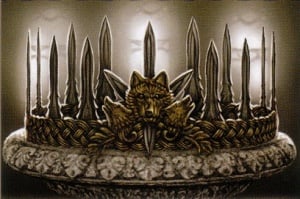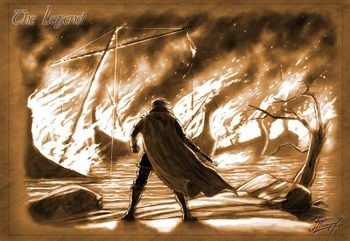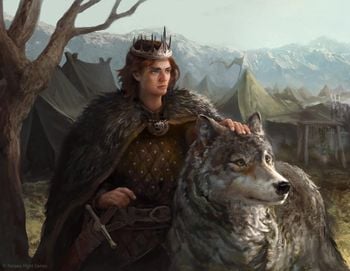King in the North
| King in the North | |
|---|---|
 Crown of Winter by John Goodenough © Fantasy Flight Games | |
| Office | Ruler of the north |
| Region | North |
| First Holder | Brandon the Builder (as King of Winter, possibly) |
| Last Holder | Robb Stark |
| Created | Age of Heroes |
| Defunct |
Aegon's Conquest 299 AC, Red Wedding |
King in the North[1] and King of Winter[2] are ancient titles held for thousands of years by House Stark of Winterfell.[3][4][5] Originating in the Age of Heroes, they ruled the last kingdom of the First Men after the southern kingdoms of Westeros fell to Andals. While the running direwolf is the sigil of House Stark, some Kings in the North had personal variants.[6]
Contents
Customs
The crown of the Kings of Winter was an open circlet of hammered bronze incised with runes of the First Men, surmounted by nine black iron spikes in the shape of longswords.[7]
The Kings in the North are buried in the crypt of Winterfell, with older kings buried in deep and dark lower levels.[8] Each king's stone statue has an iron sword across its lap and is guarded by a stone direwolf.[9] The servants of the kings are buried in a lichyard next to Winterfell's First Keep.[10]
History
Origin
House Stark traces their descent from the legendary Brandon the Builder, who is said to have lived in the Age of Heroes[11] and built the Wall and Winterfell[12] in the aftermath of the Long Night. The Kings of Winter descend from Brandon,[13][12] who might be one of the legendary Westerosi kings who allegedly ruled for hundreds of years.[14][15]
Wars
Ballads claim the ancient Kings of Winter drove giants from the north and slew the skinchangers led by Gaven Greywolf in the savage War of the Wolves. According to documents of the Nightfort, the King of Winter also killed the Warg King of Sea Dragon Point along with his sons, beasts, and greenseers, and took his daughters as prizes.[2]

The Starks warred for centuries against the Barrow Kings, a dynasty that ruled the barrowlands and styled themselves Kings of the First Men. Although the singers name this feud the Thousand Years War, runic evidence suggests that it was a period of several conflicts that lasted around two hundred years. The last war ended when the Barrow King submitted and gave his daughter's hand in marriage to the King of Winter. Other rivals vanquished by the Starks include Houses Greenwood, Towers, Amber, Frost, and a score of lesser houses and petty kings whose names are lost to history.[2]
Though the Marsh Kings are known to have once allied with the Kings of Winter against southron invaders,[2] the last Marsh King was killed by King Rickard Stark, the Laughing Wolf, who then married the slain king's daughter and annexed the Neck to his domain.[8]
Over the centuries, many other kings were defeated in turn by the Kings of Winter, including the Flints, Slates, Umbers, Lockes, Glovers, Fishers, and Ryders, all of whom would become vassals to the Starks. House Blackwood once ruled most of the wolfswood according to their own family tradition (and certain runic records translated by Maester Barneby), and were too defeated by the Starks and forced to flee south. Many of the Starks' defeated enemies were forced to yield their women as prizes or brides.[2]
The Starks' last northern rival was Rogar Bolton, the Red King of the Dreadfort. His submission ensured that the Starks would rule unchallenged as Kings in the North for thousands of years thereafter.[2]
The Stark kings often warred with the ironborn from the Iron Islands and wildlings from beyond the Wall. After the Rape of the Three Sisters, the Starks battled with the Arryn Kings of Mountain and Vale over the Bite for a thousand years in the War Across the Water.[16][17] The Starks also eventually conquered the troublesome island of Skagos.[18]
Recent Centuries
While "King of Winter" was used by ancient Stark monarchs, "King in the North" was used in more recent centuries,[2] though in later times, the term "Kings of Winter" is sometimes used colloquially to describe the Stark dynasty as a whole.[19][17]
The last King in the North was Torrhen Stark, who bent the knee to House Targaryen during Aegon's Conquest, thus bringing the north under the Iron Throne. Torrhen, the King Who Knelt, surrendered the crown of the Kings of Winter to King Aegon I Targaryen,[7] who named Torrhen as the first Warden of the North for the Seven Kingdoms.[20]
The history of the Stark kings is described in Maester Childer's Winter's Kings, or the Legends and Lineages of the Starks of Winterfell.[21]
Recent Events
A Game of Thrones
The title is revived during the War of the Five Kings after King Joffrey I Baratheon orders the execution of Eddard Stark, Lord of Winterfell. Rejecting House Baratheon of King's Landing and the Iron Throne, the northern and river lords assembled at Riverrun after the Battle of the Camps declare Eddard's eldest son, Robb, to be the King in the North.[4]
A Clash of Kings
The smith of Riverrun makes a crown for Robb inspired by the old crown of the Kings of Winter.[7]
Balon Greyjoy sends the ironborn to attack the Stony Shore, Moat Cailin, and Deepwood Motte,[22][23] and his son Theon schemes the captures of Torrhen's Square and Winterfell.[23][24] Balon styles himself "King of the Isles and the North" by right of conquest, disputing the Stark claim.[25]
A Storm of Swords
Along with being King in the North, Robb is also the King of the Trident.[26] Because of House Greyjoy's conquests, however, Robb is called by some the King Who Lost the North.[27][28]
Because he is childless and his younger brothers, Bran and Rickon, are believed dead at Theon's hands, King Robb worries that Tyrion Lannister will claim Winterfell through his marriage to Sansa Stark. According to a semi-canon source,[29] Robb decides to legitimize his bastard half-brother, Jon Snow, and names him as heir in his will.[30] Before Jon can be informed of Robb's decision, however, the king is murdered at the Twins during the Red Wedding.[31] One of Robb's betrayers, Lord Roose Bolton, is named Warden of the North by the Iron Throne.[32]
An unknowing Jon is elected Lord Commander of the Night's Watch at Castle Black.[33]
A Feast for Crows
King Balon's brother and successor, Euron Crow's Eye, continues to style himself King of the Isles and the North,[34] although he redirects the ironborn offensives to the Reach.[35]
A Dance with Dragons
When Stannis Baratheon requests homage, Lyanna Mormont answers that the Mormonts are loyal to the King in the North, who is a Stark.[36]
During the wedding feast for Ramsay Bolton and "Arya Stark" (Jeyne Poole) at Winterfell, Lady Barbrey Dustin tells the captive Theon Greyjoy that Ramsay's father, Lord Roose, may aspire to become "King of the North."[37]
Jon Snow is attacked and possibly slain by fellow members of the Night's Watch in the mutiny at Castle Black.[38]
Known Kings
The following is a possible chronology of known Kings of Winter and Kings in the North; no precise lineage is known and some published information may be contradictory.
- Antiquity
- Brandon the Builder, founder of House Stark and, according to legend, the builder of Winterfell,[3] Storm's End,[39] the Hightower,[40] and the Wall.[41] He may have ruled as a king himself.[14][42]
- Brandon the Breaker, who allied with King-Beyond-the-Wall Joramun to defeat the Night's King.[43]
- Wolf's Den
- Jon Stark, who built the Wolf's Den after driving sea raiders—possibly Ibbenese, Valyrians, or early Andals[2]—away from the White Knife.[8][44]
- Rickard Stark, the Laughing Wolf, son of Jon, who defeated the Marsh King and extended the Stark kingdom to include the Neck.[8][45]
- Theon Stark, the Hungry Wolf, who defeated the Andal warlord Argos Sevenstar, conquered the Three Sisters, and attacked the Fingers,[2] possibly beginning the War Across the Water.
- Edrick Snowbeard, who ruled for nearly a century but lost the Wolf's Den to slavers from the Stepstones.[44]
- Brandon Stark, called Ice Eyes, Edrick's great-grandson, who recovered the Wolf's Den from the slavers.[44]
- Recent kings
- Torrhen Stark, also known as the King Who Knelt, who bent the knee to Aegon the Conqueror, bringing the north under the Iron Throne.[8]
- Robb Stark, the Young Wolf, the first King in the North and King of the Trident[26] after Aegon's Conquest,[4] who never lost a battle[46] but died in the Red Wedding.[31] He was also called the King Who Lost the North.[28]
- Uncertain era

- Brandon the Shipwright, who loved to sail and built up a mighty northern fleet[8] thousands of years before Aegon's Conquest.[47]
- Brandon the Burner, who burned the northern shipyards[47] after the disappearance of his father, Brandon the Shipwright, on the Sunset Sea.[8] The north has since had no strength at sea for centuries.[48]
- Dorren Stark, who reigned when Redwyn fought giants and traded with children of the forest.[49]
- Brandon IX Stark, who destroyed the ships of the Skagosi.[18]
- Rodrik Stark, who won Bear Island from the ironborn in a wrestling match and awarded it to House Mormont.[8] This occurred after the death of the Old Kraken, Loron Greyjoy,[2] High King of the Iron Islands.[50] Rodrik's sons and grandsons battled the ironborn over Cape Kraken.[2]
- Harlon Stark, who centuries ago starved out the Dreadfort in a siege lasting two years.[51]
- Benjen the Bitter[52]
- Benjen the Sweet[52]
- Eyron Stark[52]
- Edderion the Bridegroom[52]
- Walton the Moon King[52]
- Brandon the Bad[52]
- Jorah Stark[52]
- Jonos Stark[52]
- Edwyn the Spring King[52]
- Crypt
Traveling in the crypt of Winterfell in Chapter 66 of A Game of Thrones, Bran Stark sees the statues of Kings Jon, Rickard, Theon, Brandon the Shipwright, Brandon the Burner, Rodrik, and Torrhen.[8] It is unconfirmed if this is a chronological listing.
While leaving the crypt in Chapter 69 of A Clash of Kings, Bran sees the statues of Kings Torrhen, Edwyn, Theon, Brandon the Burner, Brandon the Shipwright, Jorah, Jonos, Brandon the Bad, Walton, Edderion, Eyron, Benjen the Sweet, Benjen the Bitter, and Edrick.[5] It is unconfirmed if this is a reverse chronological listing.
In Chapter 41 of A Dance with Dragons, Theon Greyjoy recalls the names of some statues in the crypt, mentioning Kings Edrick, Brandon the Shipwright, and Theon, as well as Lord Beron.[53]
Quotes
The Kings of Winter were hard men in hard times.[2]
—writings of Yandel
The first Lords of Winterfell had been men hard as the land they ruled. In the centuries before the Dragonlords came over the sea, they had sworn allegiance to no man, styling themselves the Kings in the North.[1]
—thoughts of Eddard Stark
The old Kings of Winter are down there, sitting on their thrones with stone wolves at their feet and iron swords across their laps, but it's not them I'm afraid of.[54]
Osha: Grim folk, by the look of them.
Bran: They were the Kings of Winter.
Osha: Winter's got no king. If you'd seen it, you'd know that, summer boy.[8]
Walder: Some would say it's a poor king who crowns himself with bronze, Your Grace.
Robb: Bronze and iron are stronger than gold and silver. The old Kings of Winter wore such a sword-crown.
Walder: Small good it did them when the dragons came.[19]
—Walder Frey and Robb Stark
Bear Island knows no king but the King in the North, whose name is STARK.[36]
—Lyanna Mormont writing to Stannis Baratheon
Theon had never felt comfortable in the crypts. He could feel the stone kings staring down at him with their stone eyes, stone fingers curled around the hilts of rusted longswords. None had any love for ironborn.[53]
—thoughts of Theon Greyjoy
Truth be told, Lord Bolton aspires to more than mere lordship. Why not King of the North?[37]
References
- ↑ 1.0 1.1 A Game of Thrones, Chapter 4, Eddard I.
- ↑ 2.00 2.01 2.02 2.03 2.04 2.05 2.06 2.07 2.08 2.09 2.10 2.11 The World of Ice & Fire, The North: The Kings of Winter.
- ↑ 3.0 3.1 A Game of Thrones, Chapter 2, Catelyn I.
- ↑ 4.0 4.1 4.2 A Game of Thrones, Chapter 71, Catelyn XI.
- ↑ 5.0 5.1 A Clash of Kings, Chapter 69, Bran VII.
- ↑ So Spake Martin: Heraldry in Westeros, April 13, 1999
- ↑ 7.0 7.1 7.2 A Clash of Kings, Chapter 7, Catelyn I.
- ↑ 8.0 8.1 8.2 8.3 8.4 8.5 8.6 8.7 8.8 8.9 A Game of Thrones, Chapter 66, Bran VII.
- ↑ A Game of Thrones, Chapter 50, Arya IV.
- ↑ A Game of Thrones, Chapter 53, Bran VI.
- ↑ A Clash of Kings, Chapter 51, Jon VI.
- ↑ 12.0 12.1 The World of Ice & Fire, The North: Winterfell.
- ↑ A Game of Thrones, Appendix.
- ↑ 14.0 14.1 A Feast for Crows, Chapter 5, Samwell I.
- ↑ A Dance with Dragons, Chapter 7, Jon II.
- ↑ A Dance with Dragons, Chapter 8, Tyrion III.
- ↑ 17.0 17.1 The World of Ice & Fire, The Vale.
- ↑ 18.0 18.1 The World of Ice & Fire, The North: The Stoneborn of Skagos.
- ↑ 19.0 19.1 A Storm of Swords, Chapter 49, Catelyn VI.
- ↑ Fire & Blood, Aegon's Conquest.
- ↑ The World of Ice & Fire, Ancient History: The Dawn Age.
- ↑ A Clash of Kings, Chapter 24, Theon II.
- ↑ 23.0 23.1 A Clash of Kings, Chapter 37, Theon III.
- ↑ A Clash of Kings, Chapter 46, Bran VI.
- ↑ A Clash of Kings, Chapter 49, Tyrion XI.
- ↑ 26.0 26.1 A Storm of Swords, Chapter 14, Catelyn II.
- ↑ A Storm of Swords, Chapter 20, Catelyn III.
- ↑ 28.0 28.1 A Storm of Swords, Chapter 37, Jaime V.
- ↑ George R. R. Martin's A World of Ice and Fire, Robb Stark.
- ↑ A Storm of Swords, Chapter 45, Catelyn V.
- ↑ 31.0 31.1 A Storm of Swords, Chapter 51, Catelyn VII.
- ↑ A Storm of Swords, Chapter 72, Jaime IX.
- ↑ A Storm of Swords, Chapter 79, Jon XII.
- ↑ A Dance with Dragons, Appendix.
- ↑ A Feast for Crows, Chapter 29, The Reaver.
- ↑ 36.0 36.1 A Dance with Dragons, Chapter 3, Jon I.
- ↑ 37.0 37.1 A Dance with Dragons, Chapter 37, The Prince of Winterfell.
- ↑ A Dance with Dragons, Chapter 69, Jon XIII.
- ↑ A Clash of Kings, Chapter 31, Catelyn III.
- ↑ The World of Ice & Fire, The Reach: Oldtown.
- ↑ A Game of Thrones, Chapter 24, Bran IV.
- ↑ A Feast for Crows, Chapter 7, Cersei II.
- ↑ The World of Ice & Fire, The Wall and Beyond: The Night's Watch.
- ↑ 44.0 44.1 44.2 A Dance with Dragons, Chapter 29, Davos IV.
- ↑ The World of Ice & Fire, The North: The Crannogmen of the Neck.
- ↑ A Storm of Swords, Chapter 35, Catelyn IV.
- ↑ 47.0 47.1 Fire & Blood, Jaehaerys and Alysanne - Their Triumphs and Tragedies.
- ↑ A Clash of Kings, Chapter 16, Bran II.
- ↑ A Clash of Kings, Chapter 6, Jon I.
- ↑ A Feast for Crows, Chapter 1, The Prophet.
- ↑ A Dance with Dragons, Chapter 17, Jon IV.
- ↑ 52.0 52.1 52.2 52.3 52.4 52.5 52.6 52.7 52.8 A Clash of Kings, Chapter 66, Theon VI.
- ↑ 53.0 53.1 A Dance with Dragons, Chapter 41, The Turncloak.
- ↑ A Game of Thrones, Chapter 26, Jon IV.


